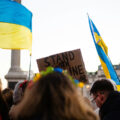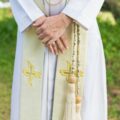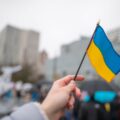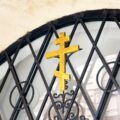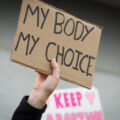Back into the bubble of religion – an Orthodox revival
Back into the bubble of religion – an Orthodox revival
“He who is not Orthodox cannot be Russian.”[1] This famous quote seems to be on its way to once again become a reality in present-day Russia. What happened to the separation between Church and State?
This article is part of our series on normativity in Europe.
“He who is not Orthodox cannot be Russian.”[1] This famous line from Fyodor Dostoevsky’s Demons (1871) seems to be on its way to once again become a normative principle in present-day Russia. Following decades of Soviet State Atheism, in which religious worship was suppressed and atheism was promoted, over the last 25 years Russian Orthodoxy has seen a revival in both the Russian Federation and in neighbouring states.[2]
A major survey carried out in 2017 showed that religion plays an important part in shaping individual and national identities throughout Eastern European countries.[3] The study makes apparent that religion and national identity are closely intertwined: to be Orthodox is to be ‘truly Russian’.[4] A previous study in 2014 showed that 72% of Russia’s population identifies as Russian Orthodox, but the 2017 survey demonstrates that Orthodox affiliation in nine of Russia’s neighbouring states varies from 73% in Belarus to 92% in Moldova.[5] [6] In contrast, after the collapse of the USSR in 1991, roughly two-thirds of Russians claimed no affiliation with any religion.[7]
Orthodoxy as a national identity
The religious sentiments in contemporary Russia and neighbouring states have become fairly similar to what they were during the times of the Russian empire, before the atheistic Soviet rule.[8] In 1832, Count Sergey Uvarov, minister of education under the imperial government of Czar Nicholas I, introduced the slogan ‘Orthodoxy, Autocracy, and Nationality’ – the three tenets on which the tsarist rule rested.[9] As one reporter notes, the Russian Orthodox Church has “regained some of its historical authority as one of the “three pillars” of tsarism under Putin’s rule.”[10] Although only 10% of Orthodox Christians across the region go to church on a weekly basis, for many, religion has become an element of national belonging, thus, again linking Orthodoxy to nationalism.[11]
This trend is not only discernible in Eastern Europe. Russian diasporic communities have also been (re)turning to Russian Orthodoxy for a sense of belonging outside of the Soviet context for decades, while Russian President Vladimir Putin recently stressed the role of the Russian Orthodox Church in strengthening ties with compatriots abroad.[12] [13]
Sociological vacuum – the quest for a new bubble
The current search for national cohesion and the return to religion in Russia evokes a theory coined by the Polish sociologist Stefan Nowak in the late 1970s: the sociological vacuum.[14] In the wake of great socio-political changes, a society faces an ideological void, lacking a sense of communal identity, or a set of normative values that creates a sense of belonging. A 2015 volume on the upsurge of nationalism in the Russian Federation shows how during the communist regimes, the population of the expansive Soviet Union was joined in a political nationalism, an overarching Soviet culture, which upon the fall of the USSR created an ideological vacuum.[15] In 1988, the leader of the USSR, Mikhail Gorbachev, recognised the looming prospect of such a social divide, or what he called “apathy and indifference,” and hailed the Orthodox Church back into public life.[16] An illustrative image that has been used in this respect, presenting the Church as a welcoming institution, is that of ‘Pokrov Bogoroditsa’ (The Mantle of the Mother of God), which refers to the protection given the faithful through the intercession of the Virgin.[17]
What about the division of Church and State?[18]
The long-standing association of Russian Orthodoxy with national identity has been invoked on multiple occasions to justify Russian expansion and political actions.[19] A telling example is Russia’s annexation of Ukraine’s Crimean Peninsula in 2014. In a speech published on the official website of the Kremlin, Vladimir Putin justified the annexation by pointing the residents of Crimea at the religious and, consequently, the cultural history that they share with the Russian Federation:
“Everything in Crimea speaks of our shared history and pride. This is the location of ancient Khersones, where Prince Vladimir was baptized. His spiritual feat of adopting Orthodoxy predetermined the overall basis of the culture, civilization, and human values that unite the peoples of Russia, Ukraine, and Belarus.”[20]
Patriarch Kirill of Moscow and All Russia, the head of the Russian Orthodox Church, also assimilates Church and State. At the 10th anniversary of his enthronement in 2019, he declared that the relationship between Church and State, “in all the history of Russia,” has never been established on such equal grounds as today. However, the patriarch also stressed that “by no means” the Russian Orthodox Church will ever support any political forces.[21] [22]
St Putin
In 2016, just outside the Kremlin in central Moscow, a 17.5-metre high monument was erected depicting Saint Vladimir, who is credited with the foundation of Orthodox Christianity in the 10th century.[23] Critics were quick to recognise ‘the other Vladimir’ in the statue, seeing it as a ‘metaphoric monument to Putin’.[24]
It is not the first instance in which Putin has been referred to as a saintly figure. The religious sect of The Chapel of Russia’s Resurrection in Nizhny Novgorod has hailed Putin as its patron saint and sees him as the reincarnation of Paul the Apostle.[25]Following Putin’s reelection in 2012, the ties between Church and State were tightened in a nationalist campaign in which the Kremlin and the Russian Orthodox Church, as one reporter notes, presented President Putin as “the protective saint of Russia,” while to some Russians he resembles a father figure.[26] [27]
“He who is not Orthodox cannot be Russian.” Dostoyevski’s statement was not merely an archaic assessment. Under the watchful eye of Putin as a resolute but saintly father and the Russian Orthodox Church as a mother who invitingly opens her cloak in a warm embrace, Russia’s national religious tradition, Russian Orthodox Christianity, has once again become normative.
Our team of analysts conducts research on topics relating to religion and society. In the second half of 2021, we are focusing on the subject of normativity. Find out more on the EARS Dashboard.
Sources
[1] Demons: A Novel in Three Parts, p. 249.
[2] Russia’s Journey from Orthodoxy to Atheism, and Back Again
[3] Religious Belief and National Belonging in Central and Eastern Europe
[4] Idem.
[5] Russians Return to Religion, But Not to Church
[6] Religious Belief and National Belonging in Central and Eastern Europe
[7] Russia’s Journey from Orthodoxy to Atheism, and Back Again
[8] Putin and the Patriarchs: how geopolitics tore apart the Orthodox church
[9] Orthodoxy, Autocracy, and Nationality
[10] Putin and the Patriarchs: how geopolitics tore apart the Orthodox church
[11] Religious Belief and National Belonging in Central and Eastern Europe
[12] Russian Spiritual Soil and the Retrieval of the Orthodox Christian Identity among Post-Soviet Immigrants to the United States
[13] Putin hails Russian Orthodox Church’s role in strengthening ties with compatriots abroad
[14] The sociological vacuum: the story of the spell cast on Polish sociologists
[15] The New Russian Nationalism, introduction.
[16] Russia’s Journey from Orthodoxy to Atheism, and Back Again
[17] A Handbook of Biblical Reception
[18] Dancing with the Church; Religion-State Relations in Russia
[19] How Putin Uses Russian Orthodoxy to Grow His Empire
[20] Address by President of the Russian Federation
[21] Church and state equal partners ‘for the first time in history’, says Russian Patriarch
[22] Patriarch Kirill vows Russian Church will never serve any political party’s interests
[23] Putin unveils ‘provocative’ Moscow statue of St Vladimir; From one Vladimir to another: Putin unveils huge statue in Moscow
[24] A New Vladimir Overlooking Moscow
[25] Sect believes Putin is a modern day St. Paul; Putin is saint and saviour for Russian cult
[26] Dancing with the Church; Religion-State Relations in Russia
[27] Putin Youth: The Young Russians Who See the President as a Father; Vladimir Putin’s portraits are everywhere

